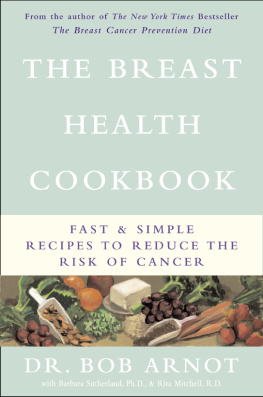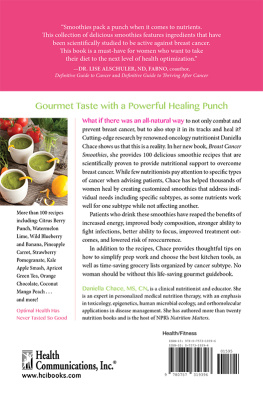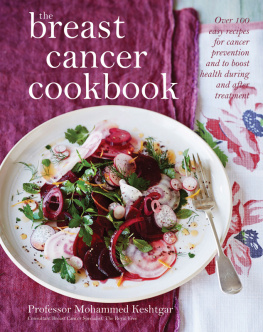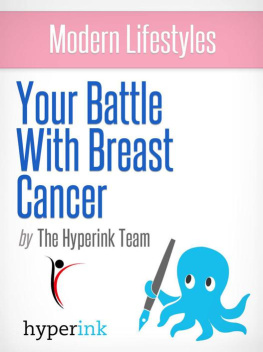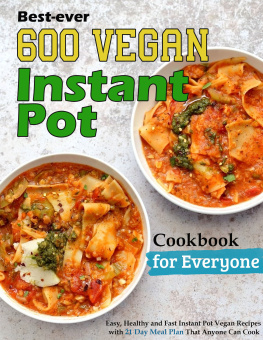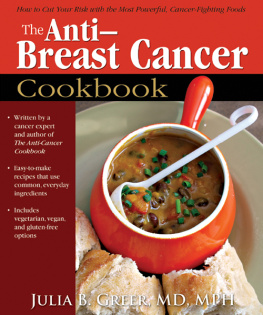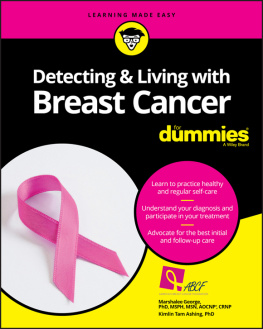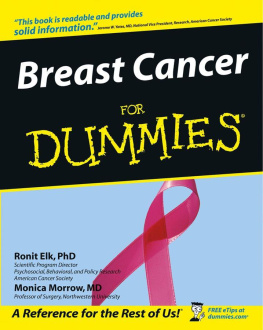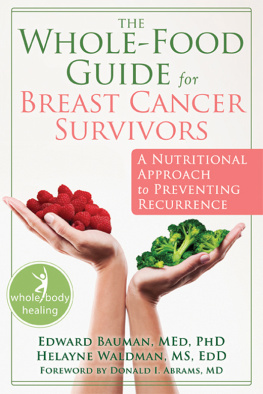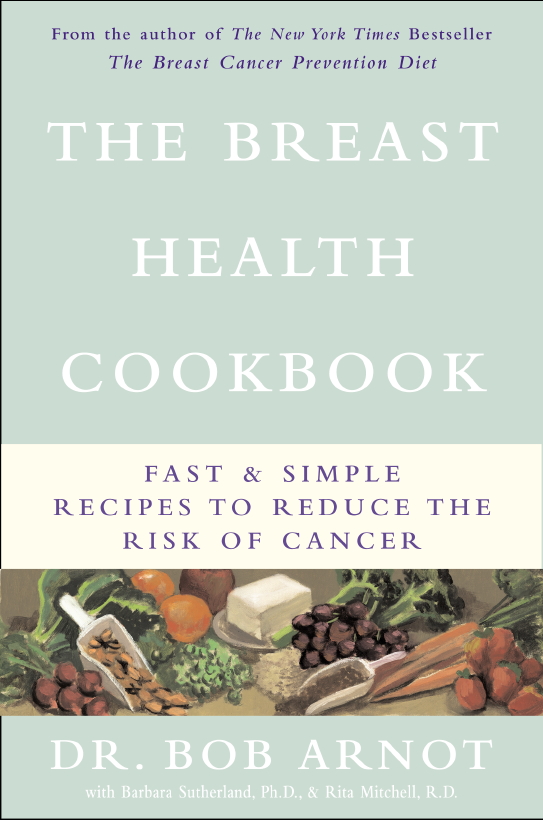ALSO BY ROBERT ARNOT, M. D .
Sport selection (with Charles Gaines)
The Best Medicine
Biology of Success
Dr. Bob Arnot's Guide to Turning Back the Clock
Dr. Bob Arnot's Revolutionary Weight Control Program
The Breast Cancer Prevention Diet
The Prostate Cancer Protection Plan
Copyright 2001 by Robert Arnot, M.D.
All rights reserved. No part of this book may be reproduced in any form or by any electronic or mechanical means, including information storage and retrieval systems, without permission in writing from the publisher, except by a reviewer who may quote brief passages in a review.
First Edition
For information on Time Warner
Trade Publishing's online publishing program, Hachette Book Group, 237 Park Avenue, New York, NY 10017
www.HachetteBookGroup.com.
The Warner Books name and logo are trademarks of Hachette Book Group, Inc.
ISBN: 978-0-7595-2171-1
M y wife, Courtney, laid down the challenge when she asked a simple question: How do I protect myself from breast cancer? She was young and afraid. Her mother had contracted breast cancer at a strikingly youthful age and Courtney feared for her own health and well-being. After a long and fascinating search, I came back to her with a treasure trove of foods that had powerful effects on the female breast. I laid out the arguments and explained to her how women in the Far East have 90 percent less breast cancer than American women. I explained how scientists believed that foods were what protected these women. I explained in great scientific detail how individual foods uniquely affect the actual biochemistry and even the structure of the very breast duct cells where cancer arises.
To my great surprise, one day after finishing the final manuscript of The Breast Cancer Prevention Diet, I found her in the kitchen eating a Philadelphia cheese steak accompanied by fat-soaked spinach pastries and polished off with a pint of high-sugar, low-fat chocolate ice cream. My face fell in dismay. I instinctively reached for the refrigerator and pulled out a burger made of soy. Have this, I offered. No way! she said. As I pulled out one food after another edamame, soy milk, tofu, miso my spirits sank. No! No! No! she said. I'd gone to great effort to create a personal program for her, but she wouldn't touch it. Why? I asked in bewilderment. The answer was simple. "Your foods don't taste good," she said. I tried to persuade her that she'd be doing herself so much good that it was worth forgoing great taste. I should have known better; I'd heard it before from food scientists. They used the same word over and over again. Ask for the three most important criteria in designing meals and they will tell you: Taste, taste, taste.
So I set out on a second journey, a journey to create meals with spectacular taste, while still incorporating every last element of a healthy-breast eating plan meals my wife, my children, and our friends would eat. Pharmacists have long formulated medications by adding many different ingredients. I wanted to formulate the perfect meal that would contain all the right foods in just the right proportions to reduce the risk of breast cancer.
That led me to two remarkable women, Barbara Sutherland, Ph.D., and Rita Mitchell, R.D. Both are first-rate, innovative nutritionists, curious scientists, and great chefs. Both work at the University of California at Berkeley. I asked them to help me create meals that could help prevent breast cancer. They jumped at the chance. They saw this book as the fruition of their lifetime quest to combine the art of cooking with the science of nutrition to prevent disease and promote health.
It came as somewhat of a surprise that Rita's and Barbara's first criterion was the same as my wife's. Their recipes had to taste great. Their "taste" judges were tough: family, friends, and neighbors. But Barbara and Rita were first hard on themselves. Until Rita saw a smile on Barbara's face and heard her exclaim, "It's a knockout!" a recipe did not reach their hard-nosed judges. My first bite of their first recipe hit me square between the eyes. WOW! I thought to myself, that tastes just about as good as any meal could. There were great tastes, subtle tastes, sparkling tastes, all surprising and delighting the palate. Sometimes they got lucky and had a great-tasting dish the first time. Other times they went back to the drawing board again and again looking for inventive ways to make the recipes work and work well with the foods necessary for the plan. It took several attempts adjusting ingredients or preparation methods before they got it right. Their philosophy was to develop recipes that tasted great, used fresh ingredients whenever possible, and were quick and easy to prepare
Rita and Barbara succeeded in spades. I now cook these meals myself, easily and quickly. The lure for me and for our family is that the dishes taste so great that they're well worth the small amount of effort it takes to prepare them instead of making a mad dash for the microwave (or the phone to order takeout).
We also learned an important lesson. As our lives have become increasingly frantic, our schedules more jumbled and our days packed with activities, we tend to overlook the importance of food. In this hectic lifestyle, we often grab food on the run or buy fast food to eat in our cars on those vast parking lots known as freeways. Many of us have lost sight of the significance of mealtimes. In addition to providing food and nourishment, mealtimes should be an opportunity to relax and enjoy life. You have to eat; you may as well take the time to select and prepare disease-fighting foods and also take the time to enjoy them! Earlier this year I traveled to Paris for Dateline NBC, to interview Professor Claude Fischler, a sociologist who studies eating behaviors. He explained how Americans not only eat badly but are also so conflicted and stressed by their poor food choices that they make an already unhealthy experience even more harmful and emotionally draining. He taught me the tremendous importance of meals as a celebration of life. At the elegant Guy Savoy restaurant in Paris, he showed me how a wonderful meal, great company, and stimulating conversation could strip away stress and create a style of life that gives us more joy and pleasure each day.
In our rushed society, we often view eating as refueling, a pit stop. While we forage for burgers, sodas, muffins, bagels, even candy bars, we miss the centerpiece of good eating great meals. The recipes in this book can be put together quickly and easily, so you don't have to rely on the local fast-food joints or convenience stores. These are meals around which you can build a great social occasion. In many cases, you can prepare part of the recipe ahead of time, making last-minute cooking a breeze. Eating is an essential part of family and social life, and it can still delight the palate while perhaps saving your life.

